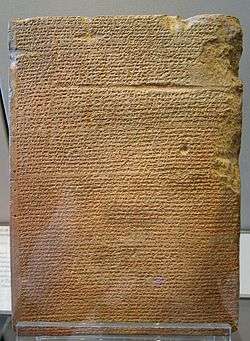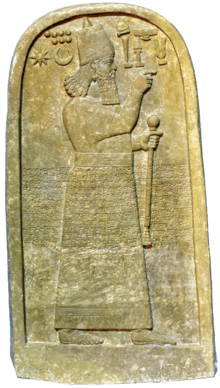Tukulti-Ninurta II
Tukulti-Ninurta II was King of Assyria from 891 BC to 884 BC. He was the second king of the Neo Assyrian Empire.
| Tukulti-Ninurta II | |
|---|---|
| |
| King of the Neo-Assyrian Empire | |
| Reign | 891–884 BC |
| Predecessor | Adad-Nirari II |
| Successor | Ashurnasirpal II |
| Died | 884 BC |
| Issue | Ashurnasirpal II |
| Father | Adad-Nirari II |
Family

His father was Adad-nirari II, the first king of the Neo-Assyrian period. His son succeeded him and was named Ashurnasirpal II. He consolidated the gains made by his father over the neo Hittites, Babylonians and Arameans, and successfully campaigned in the Zagros Mountains of Iran, subjugating the newly arrived Iranian peoples of the area, the Persians and Medes, during his brief reign.[1]
History
Tukulti-Ninurta II was victorious over Ammi-Ba'al, the king of Bit-Zamani, and then entered into a treaty with him (which included prohibitions against selling horses to Assyria's foes), as a result of which Bit-Zamani became an ally, and in fact a vassal of Assyria. Ammi-Ba'al remained in power, but from that moment on, he had to support Tukulti-Ninurta II during his military expeditions to the Upper Tigris against the Hurrians and Urartians in Nairi.[2]
Tukulti-Ninurta II developed both Nineveh and Assur, in which he improved the city walls, built palaces and temples and decorated the gardens with scenes of his military achievements.[3]
References
- George V. Yana (2008). "Ancient and Modern Assyrians: A Scientific Analysis". Xlibris Corporation. p. 149. ISBN 9781465316295.
- Edward Lipiński (2000). "The Aramaeans: Their Ancient History, Culture, Religion". Peeters Publishers. p. 517. ISBN 9789042908598.
- John Malcolm Russell (1999). "The Writing on the Wall: Studies in the Architectural Context of Late Assyrian Palace Inscriptions". Eisenbrauns. p. 222. ISBN 9780931464959.
| Preceded by Adad-nirari II |
King of Assyria 891–884 BC |
Succeeded by Ashurnasirpal II |
